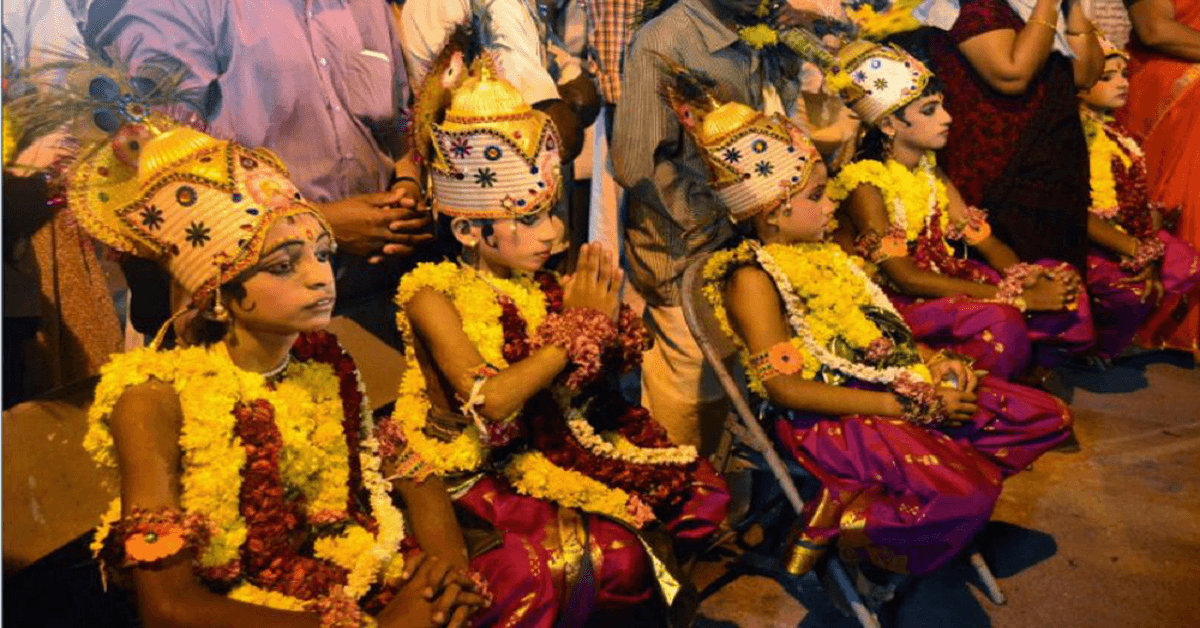
Kuthiyottam is one of the main offerings at the Chettikulangara Devi Temple and at Kadakkal Devi temple and at the Mathira Peedika Devi Temple near Kadakkal in Kollam District of Kerala.It is a ritualistic symbolic representation of human bali
Kali is one of the most significant divinities, and many texts and contexts treat Kali as an independent deity, not directly associated with a male god. In case she is associated with a male god, it is invariably Shiva. In this aspect, she represents the omnipotent Shakti of Shiva. She holds both the creative and destructive power of time.
The earliest references to Kali in Hindu tradition date back to the 6th century, and locate her in the battlefields fighting asuras. Her temples are recommended to be built away from human habitations. Vana Bhatta’s 7th-century drama Kadambari features a goddess named Chandi, an epithet of both Kali and Durga.
Kali’s most famous appearance in battle contexts are found in the Devi Mahatmya when during the battle with asuras, Durga becomes angry. Her face turns pitch dark, and suddenly Kali springs forth from Durga’s forehead. She is black, wears a garland of human heads, is clothed in a tiger skin, and wields a staff topped by a human skull. She destroys the asuras. Later, Durgoa seeks her assistance once more to annihilate Raktabija. Kali’s mythology recounts several such appearances, mostly in terrible aspects.
Young two boys between 8 and 14 years are taught Kuthiyottam, a ritual dance in the house amidst a big social gathering before the portrait of the deity. Early in the morning on Bharani, after the feast and other rituals, the boys whose body is pierced with a silver wire, one end of which is tied around their belly and an arecanut fixed on the tip of a knife held high over their head are taken in procession to the temple with the accompaniment of beating of drums, music, ornamental umbrellas, and other classical folk art forms, and richly caparisoned elephants.All through the way to the temple tender coconut water will be continually poured on their body. After the circumambulation, the boys stand at a position facing the Sreekovil (Sanctum Sanctorum) and begins to dance. This ceremony ends with dragging the wire pierced to the skin whereby a few drops of blood comes out. Kuthiyotta Kalaris’, run by Kuthiyotta Asans (Teachers or leaders), train the group to perform the dances and songs. Normally, the training starts about one to two months before the season.Boys of this locality received well training in performing Kuthiyotta chuvadu (dance)and paattu (song) from their childhood itself.
Folklore exponents see this art form, with enchanting well-structured choreography and songs, as one among the rare Adi Dravida folklore traditions still preserved and practiced in Central Kerala in accordance to the true tradition and environment. Typical to the Adi Dravida folk dances and songs, the movements and formations of dancers (clad in white thorthu and banyan) choreographed in Kuthiyottam are quick, peaks at a particular point and ends abruptly. The traditional songs also start in a stylish slow pace, then gain momentum and end abruptly.
On this day just after midday the residents of the locality bring huge decorated effigies of Bhima Panchali, Hanuman and extremely beautiful tall chariots in wheeled platforms, and after having darshan the parties take up their respective position in the paddy fields lying east of the temple.
During the night, the image of Devi will be carried in procession to the effigies stationed in the paddy fields. On the next day, these structures will be taken back. A big bazaar is also held at Chetikulangara as part of this festival. Kuthiyottam is the main vazipadu of the Chettikulangara temple, Mavelikkara. Kuthiyottam is also the main ‘vazhipadu’ of the Kadakkal Devi Temple, Kollam and at Mathira Peedika Devi Temple, Kadakkal, Kollam. The feast at Mathira Peedika is in the Thiruvathira Star of the month of Makaram.
Kuthiyottam is celebrated over 7 days, where thousands of people gather in the house of the person who conducts it. They are supposed to give food to the people who are visiting their house, whatever time it may be.
Kuthiyottam and Thalappoli are the two major events in Attukal Pongala. Boys below 12 years old are only eligible for Kuthiyottam. They have to live in the temple for last 7 days before the festival starts. They have to bow in front of the goddess for 1008 times. They have to do some special roles in Attukal Pongala day
Similar way, girls below 10 years have also some programs. That is known as Thalappoli. This will again be done on the Pongala day itself. Young girls have to wear new dresses with a flower crown in their head and have to move around the deity of the goddesses. It is believed that Thalappoli will bring joy and a healthy life.

Post Your Comments